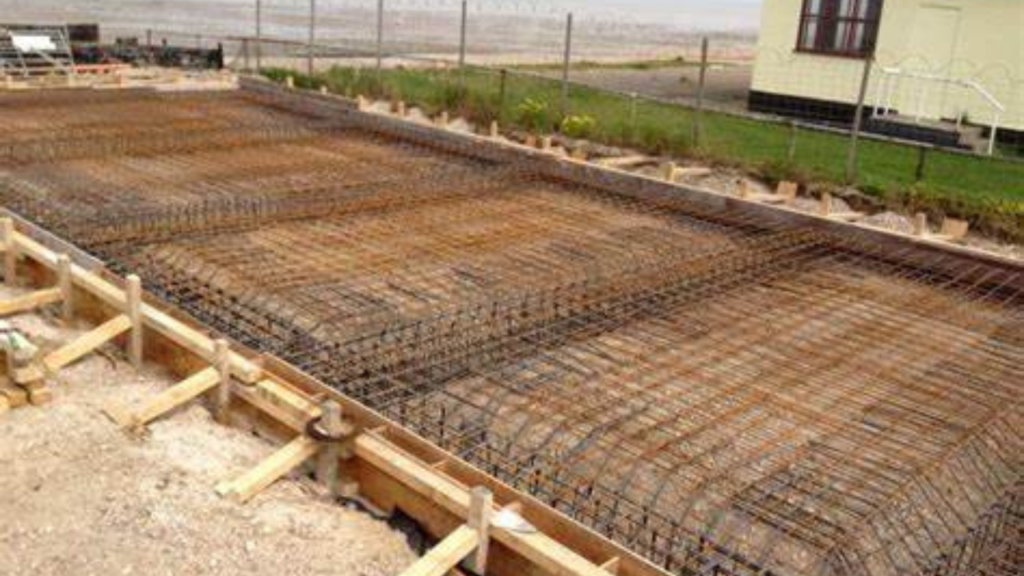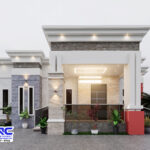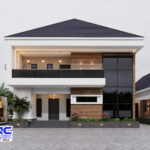When building on soft or unstable soil in Nigeria, one of the best types of foundation to consider is the raft foundation.
Also known as mat foundation, this method spreads the building load over a large area, helping to prevent uneven settling and structural cracks.
In this article, Bullionrise consult will explain what a raft foundation is, when to use it, and the advantages and disadvantages of choosing this foundation type for your building project.
Table of Contents
ToggleSee also – Which foundation is suitable for which soil?
What Is Raft Foundation?

A raft foundation is a large, thick concrete slab that covers the entire footprint of a building and supports all the walls and columns.
Think of it as a “raft” floating on the ground hence the name.
Instead of using individual footings for each column or wall, the raft acts as a single, unified base, distributing the building’s weight evenly across the ground.
It often includes reinforcements like steel bars (rebars) to add strength.
When Is Raft Foundation Used?
Raft foundations are ideal when:
- The soil has low bearing capacity (e.g., clay, swampy, or loose soil)
- The building loads are heavy
- The building is constructed on expansive or waterlogged soil
- Basements or underground structures are involved
- Other foundation types (like pad or strip) may fail
See also – What is the best way to stabilize the ground for foundation
Types of Raft Foundation
- Flat Plate Raft – simple concrete slab for light loads
- Slab with Beams – slab supported by beams for more strength
- Cellular Raft – combination of slabs and beams forming grid walls
- Piled Raft – raft foundation supported further by piles in very poor soil
Advantages of Raft Foundation
1. Suitable for Poor Soil Conditions
Raft foundations spread the building load over a large area, making them perfect for soft or loose soils where other foundations may sink.
2. Prevents Differential Settlement
By supporting the entire structure on one platform, raft foundations reduce the risk of parts of the building settling at different rates.
3. Ideal for Heavy Loads
It provides a strong base for multi-storey buildings, factories, and commercial structures.
4. Can Be Cost-Effective
When compared to individual footings for each column (especially in poor soil), a raft may be more economical.
5. Acts as a Floor Slab
In many cases, the raft can also serve as the ground floor slab, reducing additional construction costs.
See related – How do you solve foundation problems to avoid building collapse?
Disadvantages of Raft Foundation
1. High Concrete and Steel Usage
Raft foundations require a large volume of concrete and steel reinforcement, which can drive up costs.
2. Not Ideal for Small Buildings on Good Soil
Using raft foundation on firm, dry soil for a bungalow may be overkill and a waste of resources.
3. Requires Skilled Labor
Designing and constructing a raft foundation demands proper structural calculations and experienced workers.
4. Prone to Cracking If Poorly Designed
If the raft is not properly reinforced or constructed, it may develop structural cracks.
Raft Foundation vs. Other Foundation Types
- Raft Foundation is best for Weak soil, heavy buildings and can be used in Shallow Poor/soft/clay soil.
- Strip Foundation is best for Load-bearing walls, firm soil, Shallow Laterite or firm soil.
- Pile Foundation is best for deep weak soil, high-rise buildings Deep Swampy or coastal soil.
- Pad Foundation is best for Single columns, light buildings and can be used in Shallow Moderate to good soil.
Conclusion
A raft foundation is one of the most reliable and effective solutions for weak or unstable soil, especially when building large structures.
It provides strong support, minimizes settlement issues, and can save money in the long run if designed and built properly.
However, it’s not always the best choice for every project.
Always begin with a soil test and consult a structural engineer to know if raft foundation is right for your building.
Frequently asked questions
What is a raft foundation, and how does it work?
A raft foundation, also known as a mat foundation, is a large, continuous slab of concrete that supports an entire structure.
It distributes the building’s weight evenly across a wide area, making it suitable for sites with weak or unstable soil.
This foundation prevents differential settling by spreading the load over a single platform.
What are the main advantages of using a raft foundation in construction?
Raft foundations are cost-effective for large or heavy structures, as they use less material compared to individual footings.
They offer excellent load distribution, which minimizes settling issues and enhances stability.
Raft foundations are also easier to construct, as they involve less excavation and reinforcement.
Additionally, they can be used in areas with challenging soil conditions, such as soft or expansive soil.
Are there any disadvantages or limitations of raft foundations?
Raft foundations may not be suitable for sites with very steep slopes or highly compressible soil.
They require precise engineering and soil testing to ensure proper design and performance.
In areas with high water tables, additional waterproofing measures may be necessary, which can increase costs.
Also, the construction process may be time-consuming for larger buildings.
When is a raft foundation preferred over other types of foundations?
Raft foundations are preferred for structures where the ground conditions are weak or uneven and cannot support traditional footings.
They are commonly used for buildings with heavy loads, such as industrial facilities, warehouses, or multi-story complexes.
Raft foundations are also chosen when the construction site has a high risk of differential settling.
What types of structures commonly use raft foundations?
Structures that frequently use raft foundations include commercial buildings, multi-story apartments, factories, and storage facilities.
They are also popular for basements or projects requiring large spans, such as swimming pools and parking lots.
Raft foundations are ideal for sites with poor soil conditions where conventional foundations might fail.






